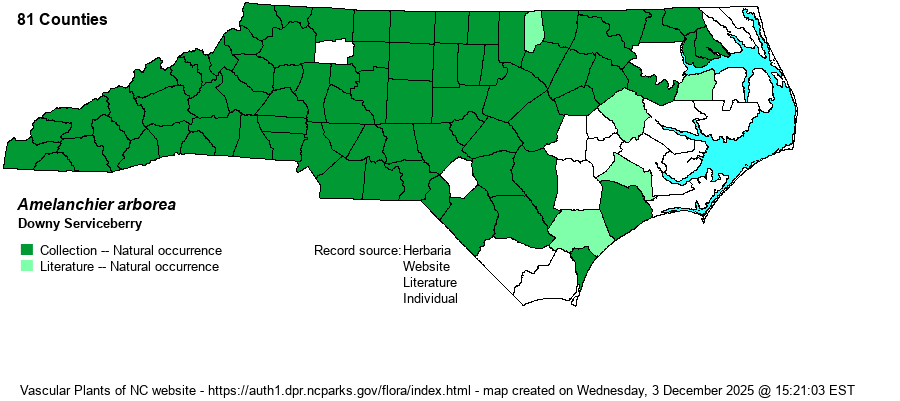| Author | (Michaux fils) Fernald | |
| Distribution | Occurs over most of the state, but primarily in the Mountains, Piedmont, and upper Coastal Plain. Of sporadic occurrence in the lower half of the Coastal Plain. Specimens from Buxton Woods and Nags Head Woods in Dare County are actually A. canadensis.
It occurs across nearly all of the eastern U.S. and southern Canada, south only to northern FL and barely to eastern TX. Ranges west to the eastern edge of the Great Plains states. | |
| Abundance | Though it occurs in all Piedmont and Mountain counties, it is only fairly common to common in these provinces, and it is seemingly declining, at least in the Piedmont. Fairly common in the upper Coastal Plain, but rare farther east (and likely absent in a few far eastern counties). It is widespread in many forest types, but it is seldom one of the more numerous woody plants in a given forest or woodland. | |
| Habitat | It is found in a wide array of forests, but is characteristic of mesic hardwood or mixed forests, rarely in bottomlands, and not considered a wetland species. It is scarce in truly dry, rocky, or sandy forested areas. |
| Phenology | Blooms in spring (March to May), often before or just as leaves are unfurling. Easily seen at a distance due to its white flowers on bare branches. Fruits from May to August. | |
| Identification | This is a deciduous, small tree, generally with a single stem and mostly growing to about 25-30 feet tall, but it can reach 50-60 feet tall in rich mountain sites. Though Amelanchier species can usually be told from other shrubs and trees by leaves with numerous small teeth and often truncate or slightly heart-shaped leaf bases, as well as the fairly large five-petaled flowers in clusters, identifying each species can be tricky. It has drooping inflorescences, and with the single trunk, most other Amelanchier species can be eliminated. See Weakley (2018) for separation from the more montane and larger-sized Allegheny Serviceberry (A. laevis). Fortunately for biologists, this is the primary or locally only Amelanchier in the Piedmont, and in upland forests in the Coastal Plain. But, in the foothills and mountains, you may have some difficulty separating these two species, which have often been considered as varieties of a single species. | |
| Taxonomic Comments | This taxon formerly included A. laevis (i.e., Amelanchier arborea laevis), a medium-sized tree restricted to the mountains and foothills. Though NatureServe Explorer recognizes several additional varieties – A. arborea var. alabamensis and A. arborea var. austromontana – in NC, these are not recognized by Weakley (2018), who does not list any varieties or subspecies for A. arborea.
| |
| Other Common Name(s) | Common Serviceberry, Downy Shadbush | |
| State Rank | S5 | |
| Global Rank | G5 | |
| State Status | | |
| US Status | | |
| USACE-agcp | FACU link |
| USACE-emp | FAC link |

